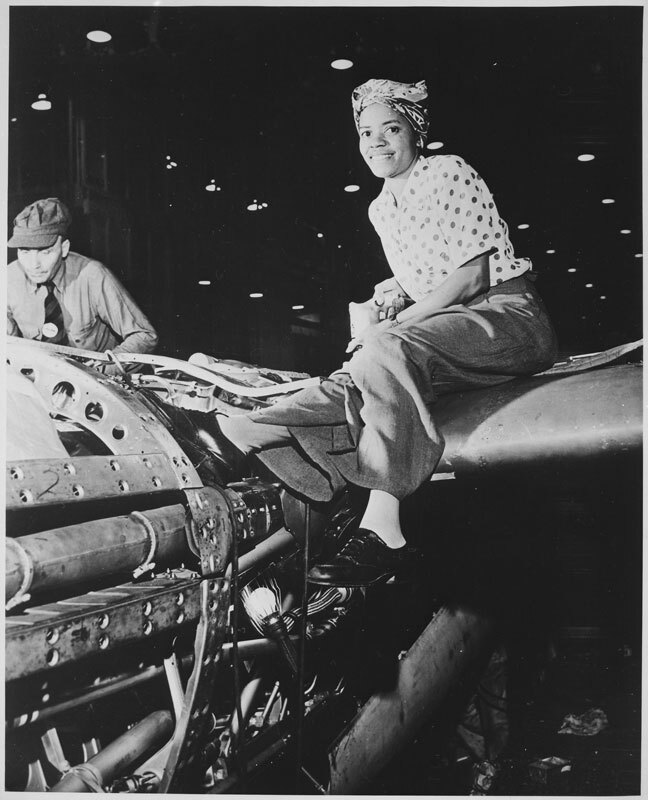What Was the Standard Womens Dress in the 40s
World War II dominated the first half of the 1940s as well as fashions in the Western world. Materials such as silk, nylon, wool, leather, rubber, and zippers were needed in wartime production. Clothing was rationed in the United States and parts of Europe. 1940s fashion designers had to be efficient and innovative in how they made suits, dresses, and shoes.

(National Archives and Records Administration)
The Effect of War on Fashion
Millions of people dressed differently during the war. Men and women wore military uniforms. Many women donned laborer's clothing, such as coveralls or trousers. In many situations, people had to make do with older or repurposed clothing rather than purchasing new styles and designs. Because of shortages and regulations, wealthier and poorer people were more likely to be dressed similarly.
However, the war caused greater regional variety in clothing styles. Paris, the longtime center of Western fashion, was cut off during the German occupation. Designers in other places gained more influence in their own countries. In several countries, laws regulated the garment industry, and manufacturers had less ability to distribute internationally.
1940s Fashion for Women
Popular Dress Styles in the 1940s
The typical 1940s female dress silhouette was like a uniform: simple and fitted, with boxy shoulders, a slim-belted waistline, and a hemline below the knee. The style shown here is for a utility dress from the United Kingdom that could be purchased with ration coupons. In cold weather, you might see women in long-sleeved dress suits of a similar shape.

In the United States, designer Claire McCardell popularized sporty, comfortable dresses that were a little roomier, including the popular popover wrap dress. She used casual fabrics such as denim, as well as more colorful and playful seersucker and jersey fabrics. Rayon became a popular, inexpensive dress fabric too.

In Germany, women's fashions were restricted during the war. The German Fashion Board encouraged women to wear traditional dirndl dresses made by German designers. Women were told not to wear makeup, trousers, furs, perfume, or glamorous clothing.
After World War II, French designer Christian Dior launched what became known as the "New Look." His style rounded the shoulders and emphasized hips with a full, pleated skirt. The hemline dropped to mid-calf or lower. These changes celebrated the end of rationing and hinted at the return of women to domestic life. Despite some criticism, the New Look remained popular into the 1950s.
Women's Pant Styles
At the beginning of the 1940s, Western women did not commonly wear trousers in public, except as active wear. But as they wore them from necessity, many women came to appreciate their comfort and practicality. A shortage of stockings (traditionally worn under dresses) gave women another reason to choose trousers.
Women's dress pants during this decade were wide-legged and high-waisted, worn with tucked-in blouses or as pantsuits with matching tops. After the war, dresses again dominated women's fashion. But pants had found a permanent place in the hearts—and wardrobes—of many women.

Women's Hairstyles, Hats, and Accessories
Women in the 1940s typically wore their hair shoulder-length or longer, without bangs, styled with waves and rolls. The "victory roll" helped women manage long hairstyles during a hard day's work; they could unroll it later into shapely waves. Women also wore turbans and head scarves, both to keep hair out of the way while working and because scarcity of hair-care products made it difficult to maintain polished styles.
Women's hats and other accessories weren't subject to much regulation during the war. Many had patriotic or military styling. Some hats were small and simple. Others used accessories to add colorful or feminine touches to the more utilitarian look of rationed clothing.
1940s Fashion for Men
Men's Suits
During the 1940s, men not in uniform often wore suits in public. Many made do with older suits from the 1930s. Suit vests fell out of favor as an excess use of fabric. New suits were made with a wool-rayon blend instead of wool and often with patterned (especially striped) fabric.
In the United Kingdom, single-breasted suits replaced double-breasted suits to preserve labor and materials. Suits and shirts were made with fewer pockets and narrower lapels. Trousers weren't allowed to have cuffs, though this style proved unpopular, and many men purchased a size too long and had them altered.

In the United States, the "Victory Suit" followed similar specifications, but the rules (and the suits) were a little looser. The baggy, colorful "zoot suit," popularized by jazz culture in the 1930s, became popular with some young Italian and Mexican immigrants, despite restrictions against making them. Some perceived zoot suits as unpatriotic.

When the war ended, baggier suits and double-breasted jackets with wider lapels became popular again. In the United States, returning soldiers enjoyed the "Bold Look" fashion: suits and ties with bolder colors and louder patterns and sports jackets in contrasting colors.
Men's Hats
A well-styled man of 1940s fashion wore a hat, though hats became less popular among younger men and after the war. Hats were most commonly made of felt. The fedora was a popular style and was often worn on an angle. A more formal variety was the homburg hat. In the summer, men might don a wide-brimmed straw hat in a variety of shapes, such as a fedora, pork pie, Panama, or boater. For active leisure, men might don a flat cap (what we think of today as newsboy style).
Fashion in Your Family History
What did your relatives wear in the 1940s? You may be able to find pictures of them in FamilySearch Memories, a free, crowdsourced collection of family photos. Or upload your own family photos to share memories of your loved ones with others who may be related to you.
Related Articles
kolodziejhomplaine.blogspot.com
Source: https://www.familysearch.org/en/blog/1940s-fashion-women-men
0 Response to "What Was the Standard Womens Dress in the 40s"
Post a Comment